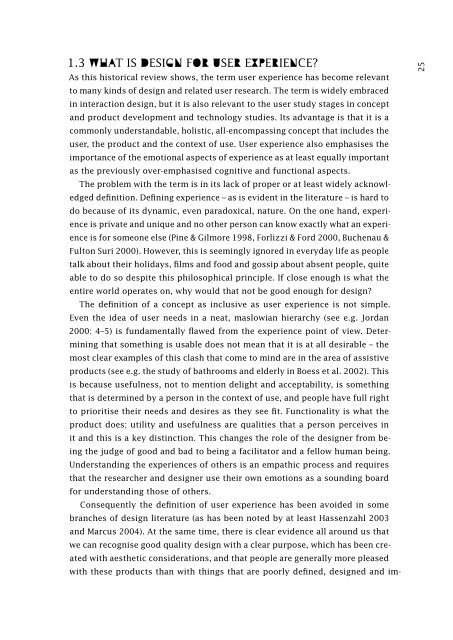Co-experience: Understanding user experiences in social interaction
Co-experience: Understanding user experiences in social interaction
Co-experience: Understanding user experiences in social interaction
You also want an ePaper? Increase the reach of your titles
YUMPU automatically turns print PDFs into web optimized ePapers that Google loves.
1.3 WHAT IS DESIGN FOR USER EXPERIENCE?<br />
As this historical review shows, the term <strong>user</strong> <strong>experience</strong> has become relevant<br />
to many k<strong>in</strong>ds of design and related <strong>user</strong> research. The term is widely embraced<br />
<strong>in</strong> <strong>in</strong>teraction design, but it is also relevant to the <strong>user</strong> study stages <strong>in</strong> concept<br />
and product development and technology studies. Its advantage is that it is a<br />
commonly understandable, holistic, all-encompass<strong>in</strong>g concept that <strong>in</strong>cludes the<br />
<strong>user</strong>, the product and the context of use. User <strong>experience</strong> also emphasises the<br />
importance of the emotional aspects of <strong>experience</strong> as at least equally important<br />
as the previously over-emphasised cognitive and functional aspects.<br />
The problem with the term is <strong>in</strong> its lack of proper or at least widely acknowledged<br />
def<strong>in</strong>ition. Def<strong>in</strong><strong>in</strong>g <strong>experience</strong> – as is evident <strong>in</strong> the literature – is hard to<br />
do because of its dynamic, even paradoxical, nature. On the one hand, <strong>experience</strong><br />
is private and unique and no other person can know exactly what an <strong>experience</strong><br />
is for someone else (P<strong>in</strong>e & Gilmore 1998, Forlizzi & Ford 2000, Buchenau &<br />
Fulton Suri 2000). However, this is seem<strong>in</strong>gly ignored <strong>in</strong> everyday life as people<br />
talk about their holidays, films and food and gossip about absent people, quite<br />
able to do so despite this philosophical pr<strong>in</strong>ciple. If close enough is what the<br />
entire world operates on, why would that not be good enough for design?<br />
The def<strong>in</strong>ition of a concept as <strong>in</strong>clusive as <strong>user</strong> <strong>experience</strong> is not simple.<br />
Even the idea of <strong>user</strong> needs <strong>in</strong> a neat, maslowian hierarchy (see e.g. Jordan<br />
2000: 4–5) is fundamentally flawed from the <strong>experience</strong> po<strong>in</strong>t of view. Determ<strong>in</strong><strong>in</strong>g<br />
that someth<strong>in</strong>g is usable does not mean that it is at all desirable – the<br />
most clear examples of this clash that come to m<strong>in</strong>d are <strong>in</strong> the area of assistive<br />
products (see e.g. the study of bathrooms and elderly <strong>in</strong> Boess et al. 2002). This<br />
is because usefulness, not to mention delight and acceptability, is someth<strong>in</strong>g<br />
that is determ<strong>in</strong>ed by a person <strong>in</strong> the context of use, and people have full right<br />
to prioritise their needs and desires as they see fit. Functionality is what the<br />
product does; utility and usefulness are qualities that a person perceives <strong>in</strong><br />
it and this is a key dist<strong>in</strong>ction. This changes the role of the designer from be<strong>in</strong>g<br />
the judge of good and bad to be<strong>in</strong>g a facilitator and a fellow human be<strong>in</strong>g.<br />
<strong>Understand<strong>in</strong>g</strong> the <strong>experience</strong>s of others is an empathic process and requires<br />
that the researcher and designer use their own emotions as a sound<strong>in</strong>g board<br />
for understand<strong>in</strong>g those of others.<br />
<strong>Co</strong>nsequently the def<strong>in</strong>ition of <strong>user</strong> <strong>experience</strong> has been avoided <strong>in</strong> some<br />
branches of design literature (as has been noted by at least Hassenzahl 2003<br />
and Marcus 2004). At the same time, there is clear evidence all around us that<br />
we can recognise good quality design with a clear purpose, which has been created<br />
with aesthetic considerations, and that people are generally more pleased<br />
with these products than with th<strong>in</strong>gs that are poorly def<strong>in</strong>ed, designed and im-<br />
25

















